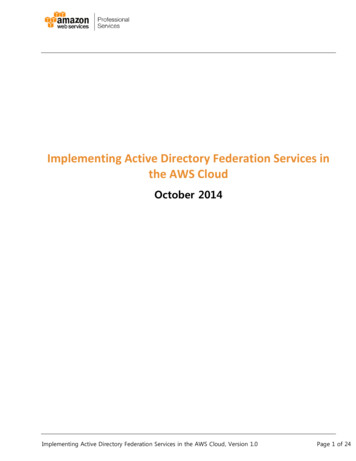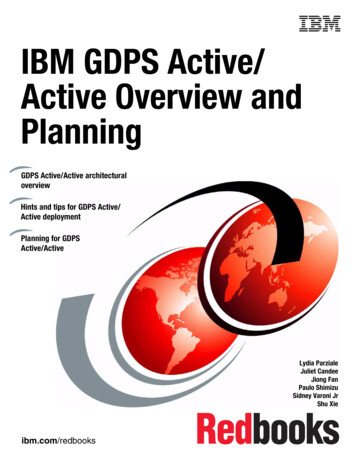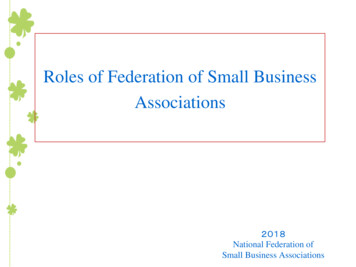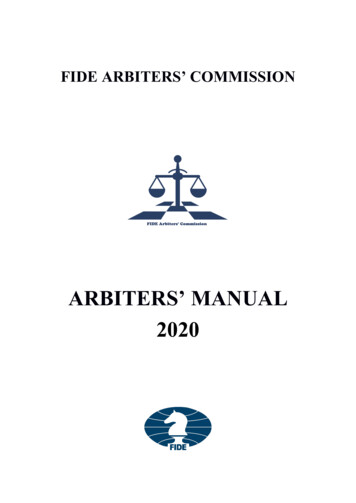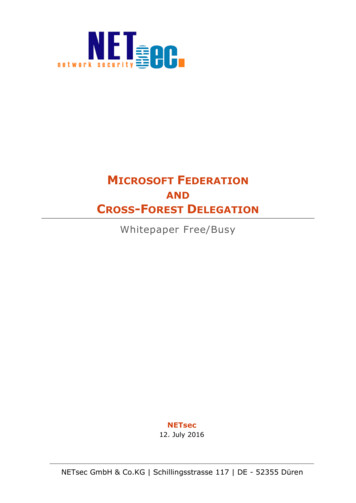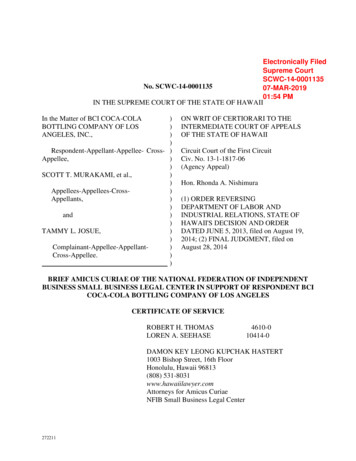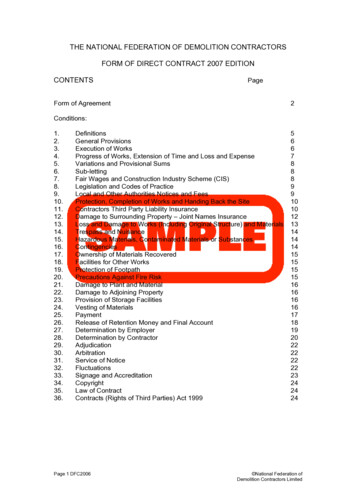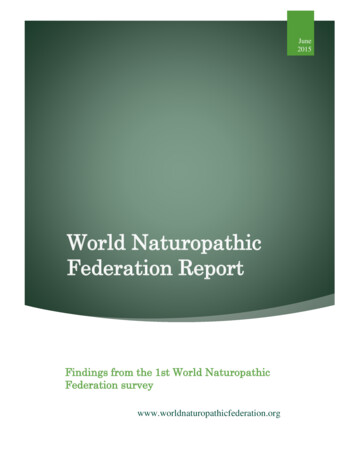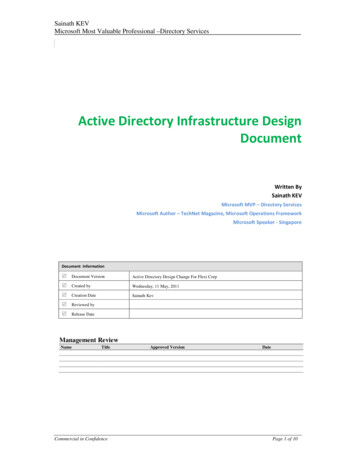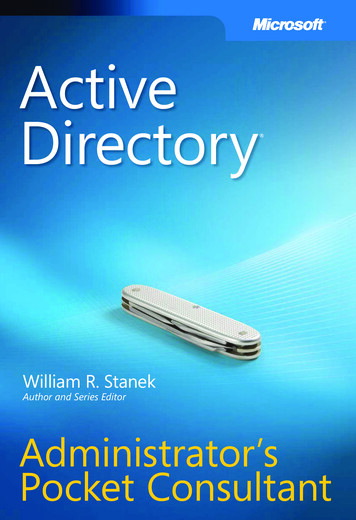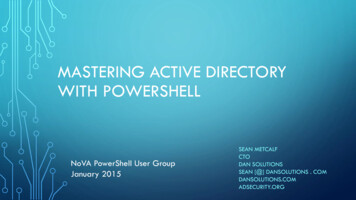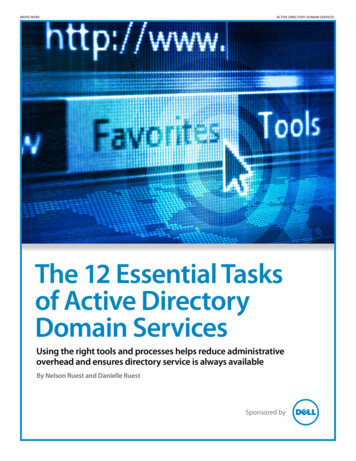![[MS-ADFSOD]: Active Directory Federation Services (AD FS .](/img/1/5bms-adfsod-5d.jpg)
Transcription
[MS-ADFSOD]:Active Directory Federation Services (AD FS) ProtocolsOverviewIntellectual Property Rights Notice for Open Specifications Documentation Technical Documentation. Microsoft publishes Open Specifications documentation (“thisdocumentation”) for protocols, file formats, data portability, computer languages, and standardssupport. Additionally, overview documents cover inter-protocol relationships and interactions.Copyrights. This documentation is covered by Microsoft copyrights. Regardless of any otherterms that are contained in the terms of use for the Microsoft website that hosts thisdocumentation, you can make copies of it in order to develop implementations of the technologiesthat are described in this documentation and can distribute portions of it in your implementationsthat use these technologies or in your documentation as necessary to properly document theimplementation. You can also distribute in your implementation, with or without modification, anyschemas, IDLs, or code samples that are included in the documentation. This permission alsoapplies to any documents that are referenced in the Open Specifications documentation.No Trade Secrets. Microsoft does not claim any trade secret rights in this documentation.Patents. Microsoft has patents that might cover your implementations of the technologiesdescribed in the Open Specifications documentation. Neither this notice nor Microsoft's delivery ofthis documentation grants any licenses under those patents or any other Microsoft patents.However, a given Open Specifications document might be covered by the Microsoft OpenSpecifications Promise or the Microsoft Community Promise. If you would prefer a written license,or if the technologies described in this documentation are not covered by the Open SpecificationsPromise or Community Promise, as applicable, patent licenses are available by contactingiplg@microsoft.com.License Programs. To see all of the protocols in scope under a specific license program and theassociated patents, visit the Patent Map.Trademarks. The names of companies and products contained in this documentation might becovered by trademarks or similar intellectual property rights. This notice does not grant anylicenses under those rights. For a list of Microsoft trademarks, visitwww.microsoft.com/trademarks.Fictitious Names. The example companies, organizations, products, domain names, emailaddresses, logos, people, places, and events that are depicted in this documentation are fictitious.No association with any real company, organization, product, domain name, email address, logo,person, place, or event is intended or should be inferred.Reservation of Rights. All other rights are reserved, and this notice does not grant any rights otherthan as specifically described above, whether by implication, estoppel, or otherwise.Tools. The Open Specifications documentation does not require the use of Microsoft programmingtools or programming environments in order for you to develop an implementation. If you have accessto Microsoft programming tools and environments, you are free to take advantage of them. CertainOpen Specifications documents are intended for use in conjunction with publicly available standardsspecifications and network programming art and, as such, assume that the reader either is familiarwith the aforementioned material or has immediate access to it.Support. For questions and support, please contact dochelp@microsoft.com.1 / 30[MS-ADFSOD] - v20210603Active Directory Federation Services (AD FS) Protocols OverviewCopyright 2021 Microsoft CorporationRelease: June 3, 2021
Revision 3/20141.0NewReleased new document.5/15/20141.0NoneNo changes to the meaning, language, or formatting of thetechnical content.6/30/20152.0MajorSignificantly changed the technical content.9/24/20153.0MajorSignificantly changed the technical content.10/16/20153.0NoneNo changes to the meaning, language, or formatting of thetechnical content.9/26/20164.0MajorSignificantly changed the technical content.6/1/20175.0MajorSignificantly changed the technical content.12/15/20176.0MajorSignificantly changed the technical content.11/5/20187.0MajorSignificantly changed the technical content.6/3/20218.0MajorSignificantly changed the technical content.2 / 30[MS-ADFSOD] - v20210603Active Directory Federation Services (AD FS) Protocols OverviewCopyright 2021 Microsoft CorporationRelease: June 3, 2021
Table of Contents1Introduction . 41.1Glossary . 41.2References . 61.3Overview . 81.4Prerequisites/Preconditions . 82Functional Description . 102.1Summary of Protocols. 112.2Components and Capabilities . 132.2.1STS Token Generation . 132.2.1.1WS-Federation. 132.2.1.2WS-Trust . 142.2.1.3OAuth and OpenID Connect. 142.2.1.4SAML . 162.2.2STS Deployed on the Edge . 162.2.3Device Registration . 172.2.4Authentication Using JSON Web Tokens . 182.3Protocol Relationships . 182.4Coherency Requirements . 182.5Security . 182.6Additional Considerations . 183Use Cases . 193.1Single Sign-on Using a Security Token Service and WS-Federation . 193.1.1Success Cases . 213.1.1.1User and Relying Party in Different Realms Example . 213.1.1.2User and Relying Party in Same Realm Example . 244Appendix A: Product Behavior . 275Change Tracking . 296Index . 303 / 30[MS-ADFSOD] - v20210603Active Directory Federation Services (AD FS) Protocols OverviewCopyright 2021 Microsoft CorporationRelease: June 3, 2021
1IntroductionThis document provides an overview of the protocols that support Active Directory FederationServices (AD FS).1.1GlossaryThis document uses the following terms:Active Directory: The Windows implementation of a general-purpose directory service, which usesLDAP as its primary access protocol. Active Directory stores information about a variety ofobjects in the network such as user accounts, computer accounts, groups, and all relatedcredential information used by Kerberos [MS-KILE]. Active Directory is either deployed asActive Directory Domain Services (AD DS) or Active Directory Lightweight DirectoryServices (AD LDS), which are both described in [MS-ADOD]: Active Directory ProtocolsOverview.Active Directory Domain Services (AD DS): A directory service (DS) implemented by a domaincontroller (DC). The DS provides a data store for objects that is distributed across multiple DCs.The DCs interoperate as peers to ensure that a local change to an object replicates correctlyacross DCs. AD DS is a deployment of Active Directory [MS-ADTS].Active Directory Federation Services (AD FS): A Microsoft implementation of a federationservices provider, which provides a security token service (STS) that can issue security tokensto a caller using various protocols such as WS-Trust, WS-Federation, and Security AssertionMarkup Language (SAML) version 2.0.Active Directory Federation Services (AD FS) farm: A collection of AD FS servers that istypically maintained by an enterprise to obtain greater redundancy and offer more reliableservice than a single standalone AD FS server.ADFSOAL: The Active Directory Federation Services OAuth Authorization Code Lookup Protocol[MS-ADFSOAL].ADFSPIP: The Active Directory Federation Services and Proxy Integration Protocol [MS-ADFSPIP].ADFSPP: Active Directory Federation Service (AD FS) Proxy Protocol [MS-ADFSPP]ADFSWAP: Active Directory Federation Service (AD FS) Web Agent Protocol [MS-ADFSWAP].authorization code: An authorization code as defined in [RFC6749] section 1.3.1.certificate: When referring to X.509v3 certificates, that information consists of a public key, adistinguished name (DN) of some entity assumed to have control over the private keycorresponding to the public key in the certificate, and some number of other attributes andextensions assumed to relate to the entity thus referenced. Other forms of certificates can bindother pieces of information.claim: A declaration made by an entity (for example, name, identity, key, group, privilege, andcapability). For more information, see [WSFederation1.2].federation: A collection of security realms that have established trust.Hypertext Transfer Protocol (HTTP): An application-level protocol for distributed, collaborative,hypermedia information systems (text, graphic images, sound, video, and other multimediafiles) on the World Wide Web.JavaScript Object Notation (JSON): A text-based, data interchange format that is used totransmit structured data, typically in Asynchronous JavaScript XML (AJAX) web applications,4 / 30[MS-ADFSOD] - v20210603Active Directory Federation Services (AD FS) Protocols OverviewCopyright 2021 Microsoft CorporationRelease: June 3, 2021
as described in [RFC7159]. The JSON format is based on the structure of ECMAScript (Jscript,JavaScript) objects.JSON Web Token (JWT): A type of token that includes a set of claims encoded as a JSON object.For more information, see [RFC7519].locally unique identifier (LUID): A 64-bit value guaranteed to be unique within the scope of asingle machine.MWBE: Microsoft Web Browser Federated Sign-On Protocol Extensions [MS-MWBE].MWBF: Microsoft Web Browser Federated Sign-On Protocol [MS-MWBF].OAPX: OAuth 2.0 Protocol Extensions [MS-OAPX].OAuth: The OAuth 2.0 authorization framework [RFC6749].pre-authentication: In Active Directory Federation Services (AD FS), the act of enforcingauthentication of a user on the edge of a protected network boundary.realm: An administrative boundary that uses one set of authentication servers to manage anddeploy a single set of unique identifiers. A realm is a unique logon space.relying party (RP): A web application or service that consumes security tokens issued by asecurity token service (STS).Representational State Transfer (REST): A class of web services that is used to transferdomain-specific data by using HTTP, without additional messaging layers or session tracking,and returns textual data, such as XML.SAML1: The Security Assertion Markup Language (SAML) 1.1 [SAMLCore].SAML2: The Security Assertion Markup Language (SAML) 2.0 [SAMLCore2].SAMLPR: Security Assertion Markup Language (SAML) Proxy Request Signing Protocol [MSSAMLPR].Secure Sockets Layer (SSL): A security protocol that supports confidentiality and integrity ofmessages in client and server applications that communicate over open networks. SSL supportsserver and, optionally, client authentication using X.509 certificates [X509] and [RFC5280].SSL is superseded by Transport Layer Security (TLS). TLS version 1.0 is based on SSLversion 3.0 [SSL3].security identifier (SID): An identifier for security principals that is used to identify an accountor a group. Conceptually, the SID is composed of an account authority portion (typically adomain) and a smaller integer representing an identity relative to the account authority, termedthe relative identifier (RID). The SID format is specified in [MS-DTYP] section 2.4.2; a stringrepresentation of SIDs is specified in [MS-DTYP] section 2.4.2 and [MS-AZOD] section 1.1.1.2.security token: A collection of one or more claims. Specifically in the case of mobile devices, asecurity token represents a previously authenticated user as defined in the Mobile DeviceEnrollment Protocol [MS-MDE].security token service (STS): A web service that issues security tokens. That is, it makesassertions based on evidence that it trusts; these assertions are for consumption by whoevertrusts it.single sign-on (SSO): An authentication and authorization scheme in which a user needs onlyone set of credentials in order to access unrelated network resources.5 / 30[MS-ADFSOD] - v20210603Active Directory Federation Services (AD FS) Pro
Active Directory: The Windows implementation of a general-purpose directory service, which uses LDAP as its primary access protocol. Active Directory stores information about a variety of objects in the network such as user accounts, computer accounts, groups, and all related credential information used by Kerberos [MS-KILE]. Active Directory is either deployed as Active Directory Domain .
